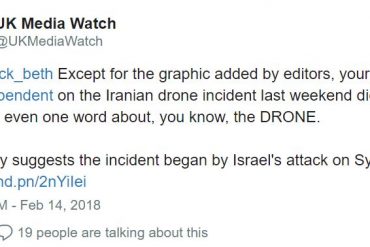A member of the public searching online for information on the Six Day War from the BBC will encounter the two maps below among the top results.
The text to the first map reads:
“Six-Day War: Before the war
From 1948 to 1967, the West Bank, including East Jerusalem, was ruled by Jordan. During this period, the Gaza Strip was under Egyptian military administration. Israeli troops captured Egypt’s Sinai peninsula during the 1956 British, French and Israeli military campaign in response to the nationalisation of the Suez Canal. The Israelis subsequently withdrew and were replaced with a UN force. In 1967, Egypt ordered the UN troops out and blocked Israeli shipping routes – adding to already high levels of tension between Israel and its neighbours.”
That explanation of course neglects to clarify to readers that rather than the regions described in the text being “ruled” (as the BBC so benignly puts it) by Jordan, they were in fact occupied, with Jordan’s subsequent annexation of those areas not recognized by the international community. It also fails to clarify that the same area had been designated as part of the homeland for the Jewish people at the San Remo conference in 1920 – along with the Gaza Strip which was similarly occupied by Egypt from 1948 to 1956 and from 1957 to 1967 – and that both areas were conquered by those invading foreign armies during the War of Independence.
The BBC’s cursory description of the period immediately before the outbreak of the Six Day War fails to describe the organized build-up of Egyptian, Syrian, Jordanian, Saudi Arabian and Iraqi troops on Israel’s borders from May 25th 1967 or the May 30th defence pact between Egypt and Jordan. No mention is made of the fact that by that time, some 500,000 troops, 5,000 tanks and 1,000 warplanes surrounded Israel or of the threatening rhetoric of numerous Arab leaders.
“All of the Arab armies now surround Israel. The UAR, Iraq, Syria, Jordan, Yemen, Lebanon, Algeria, Sudan, and Kuwait. … There is no difference between one Arab people and another, no difference between one Arab army and another.” – King Hussein of Jordan, after signing the pact with Egypt May 30, 1967
“The existence of Israel is an error which must be rectified. This is our opportunity to wipe out the ignominy which has been with us since 1948. Our goal is clear – to wipe Israel off the map. We shall, God willing, meet in Tel Aviv and Haifa.” – President Abdel Rahman Aref of Iraq, May 31, 1967
Syria’s forces are “ready not only to repulse the aggression, but to initiate the act of liberation itself, and to explode the Zionist presence in the Arab homeland. The Syrian army, with its finger on the trigger, is united…. I as a military man, believe that the time has come to enter into a battle of annihilation.” – Syrian Defense Minister Hafez Assad, May 20, 1967
Those omissions mean that the BBC is able to open the text appearing under the second map with the inaccurate claim that it was Israel’s pre-emptive attack on Egyptian airfields which “drew Syria and Jordan into a regional war”.
“Six-Day War: After the war
In a pre-emptive attack on Egypt that drew Syria and Jordan into a regional war in 1967, Israel made massive territorial gains capturing the West Bank, Gaza Strip, Golan Heights and the Sinai Peninsula up to the Suez Canal.”
Clearly, the misleading and inaccurate text accompanying these two maps fails to provide BBC audiences with an accurate and impartial view of the causes of the Six Day War.





